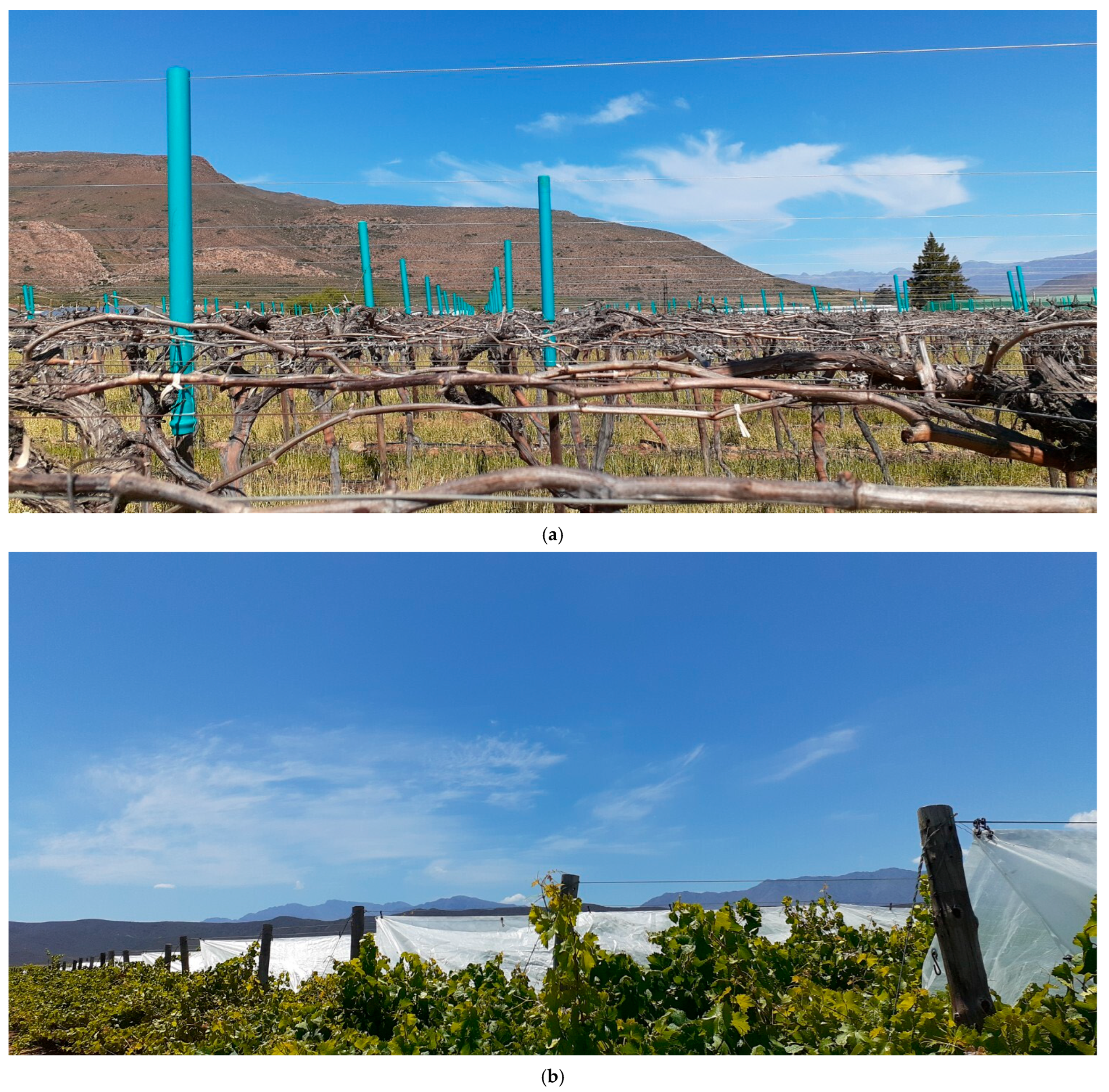1. Introduction
Changes in photosynthetic activity, stomatal movement, internal CO
2 concentration, transpiration, and stem water potential are related to plant water relations [
1,
2]. Stomatal movement regulates water loss [
1,
2] and is dictated by environmental conditions, such as soil water availability [
3]. Responses to water deficits become more pronounced when water deficit conditions are combined with high vapour pressure deficits [
4], high light intensities [
5], and high temperature conditions [
6].
In a specific micro-climatic environment, the atmospheric temperatures surrounding the leaves affect leaf water potential and gas exchange [
7]. Above 35 °C, photosynthesis may decline [
6]. The negative effects of high temperatures on photosynthesis can be mitigated by water availability since higher stomatal conductance and transpiration rates associated with high temperature enhance leaf cooling when root water absorption is not limited [
8,
9]. In this regard, increased photosynthetic rates have been reported for sun-exposed leaves of irrigated Shiraz vines in an enclosed field chamber at a temperature of 40 °C for three days [
10]. In cooler regions, with temperatures between 15 °C and 25 °C, stomatal closure and photosynthesis can be restricted [
11].
The severity of water deficit conditions determines grapevine physiological responses and can be classified as mild, moderate, and severe [
12,
13]. However, responses may vary under the same conditions for different cultivars [
14]. Stomatal closure is an initial response to water deficit conditions, which influences photosynthesis [
1,
2,
12]. In addition to stomatal responses, decreases in photosynthetic rates under moderate water stress conditions can be ascribed to non-stomatal responses, such as carbohydrate accumulation [
15]. Severe water deficit conditions cause a sharp decline in CO
2 assimilation, electron transport rate, and carboxylation, whereas non-photochemical quenching increases [
12] and Rubisco activity becomes inhibited [
14]. However, the down regulation of Rubisco activity is not easily proven under field conditions [
16].
Generally, under mild water deficit conditions, elevated CO
2 levels increase photosynthetic activity and enable the use of CO
2-induced carbohydrates for structural growth [
15,
17]. Elevated CO
2 may lead to photosynthetic acclimation in the long-term [
15,
18].
Manipulation of the micro-climatic environment is a means to buffer table grape vines against environmental conditions. Alternative cultivation practices, such as cultivation under protection, in addition to/as opposed to standard cultivation practices, may be used to achieve this goal. The purpose of cultivation determines the time of plastic cover installation. When vineyards are protected with overhead plastic covers directly after accumulation of the required number of chill units, budbreak, and thus ripening, are enhanced [
19]. Late covering, at the start of ripening, is a technique adopted to delay the harvest [
19]. Vines can be protected against adverse environmental conditions throughout the entire growing season by covering the vineyard just after budbreak and then removing the covers when the leaves fall [
19].
The use of overhead protective covers is a general practice in many table grape cultivation areas, especially where environmental conditions, such as rain, pose threats for losses during the ripening period [
20,
21]. Covering vineyards with thin protective plastic films during ripening protects harvests against rain and diseases [
19,
22].
Apart from a protective function, overhead plastic covering (OPC) can temper micro-climatic conditions by decreasing temperature and increasing humidity, ensuring conditions for plant performance to be more favourable for phenolic and total soluble solids accumulation [
23]. Compared to open field (OF) conditions, OPC contributes to lower evapotranspiration [
24] due to lower radiation reaching the soil surface [
25], thus preserving the soil water content (SWC). Da Silva et al. (2018) [
26] reported a water saving when the top sides of Niagara Rosada grapevines were covered with transparent plastic covers. The light spectrum underneath OPC is determined by the radiometric properties of the plastic product [
27]. The radiometric properties of the products used for overhead covering are vital because of the light conditions inside the canopy and around the bunches that facilitate plant productivity by activating genes and enzymes [
28,
29] through a thermal or a phytochrome effect [
30]. Ideally, the light environment conditions must allow for approximately 60% of phytochrome to be in the far-red form [
31] (Smith, 1982) because of its role in the activation of, e.g., nitrate reductase [
30,
32]. Overhead plastic covers with high transmissivity for photosynthetic active radiation (PAR) ensure optimal photosynthesis [
33,
34], if temperatures do not increase beyond 35 °C and water is available [
33,
35]. Material with a solar transmissivity of at least 80% is required to ensure adequate illumination of the canopy to allow its regular functioning; furthermore, the solar transmissivity of the plastic sheet is partly responsible for the temperature of the confined environment [
20,
21]. Transmittance for ultraviolet (UV) light favours production of secondary compounds, such as phenols, volatiles, and carotenoids [
28,
36], whereas transmittance of excessive UV-B fluence rates destroys proteins [
37]. Low transmissions of long-wave infrared ensure R/FR ratios favouring the active form of phytochrome for the activity of various enzymes necessary to produce secondary compounds [
30,
31,
32]
Local studies have defined ranges for the degree of water deficit in terms of Ψ
S for various table grape cultivars grown under open field conditions [
38]. The limited available scientific information on physiological processes, such as Pn, Tr, and Ψ
S, of table grape vines in response to drought and other micro-climatic conditions, such as altered temperatures and RH around the leaves and bunches under South African conditions, hinders technological advancement and thus efficient management of growth. Limited water supply and changes in the climate create challenging conditions, which require an understanding of the physiological status of table grape vines. Understanding plant responses to altered environmental conditions is critical to develop tools for regulatory management of growth balances under such challenging conditions.
The study aimed to (1) determine grapevine reaction to three levels of reduced water supply compared to the on-farm treatment, which was the amount of water needed in terms of crop evapotranspiration, and (2) determine grapevine reaction during the growth season to the four water supply treatments in OF conditions, and in conditions where the micro-climatic environment had been changed by means of OPC. The objectives of the study were to (1) obtain a better understanding of the vine reactions in terms of the SWP, Pn, and Tr under conditions of altered water supply and different micro-climatic environments (OF and OPC), and (2) provide producers with evaluation and measurement tools related to SWP and responses related to photosynthesis.
3. Discussion
The direct relationship between clay contents and soil water content [
39] were applicable to the differences in WHC. The differences in WHC between the W070 and W080 treatment plots of the OF trial were ascribed to texture differences, i.e., higher clay content and lower sand content of the W070 treatments (
Table 1).
Calcium and Mg dominated the exchange complex of the clay particles in the OF and OPC trials. The cation exchange capacity of clay particles was evident at 30 cm soil depth in the W070 and W080 sampling plots. The higher clay content in the sampling plots of the W070 treatments may explain the lower base saturation values for Ca and the higher base saturation values for Mg in the sampled plots of the W070 treatments as opposed to the sampled plots of the W080 treatments in the OF trial [
40]. Increased K in the W070 plots compared to the W080 plots was likely due to the release of K from the clay particles, which could have been supported by the high WHC of the W070 treatment [
41]. Water holding capacity, the base saturation values for Ca and Mg, as well as the exchangeable K for the W070 as opposed to the W080 sampling plots, were all related to the clay content.
The pH
KCl values ranging between 5.5 and 6.5 were within the ideal range for grapevines [
39]. With the pH
KCl values within the acceptable range, the availability of essential nutrients, such as Ca and Mg, was thus ensured [
39].
The W070 treatment resulted in similar SWC to that of the W080 treatment, despite higher volumes of water applied in the latter. As reported by Ramos et al. [
42], soils with a higher WHC, such as the soil in the W070 treatment plots of the OF trial (
Table 1), maintain more moisture for longer. Similarly, Martínez-Vidaurre et al. [
43] reported that soils with a higher WHC had more available water, resulting in Tempranillo/Richter 110 vines being less stressed. The results of Tramontini et al. [
3] demonstrated the importance of soil water availability for the improvement of rates of CO
2 assimilation, transpiration, and stomatal conductance. The higher SWC in the OPC trial may be ascribed to the covers providing shade. Overhead plastic covers lower evapotranspiration by decreasing the radiation reaching the soil surface, lowering evaporation [
21,
24,
25].
Average air T in the MIC never increased to above 35 °C (
Table 4,
Table 5 and
Table 6), the temperature above which net photosynthesis is known to decline [
6]. The air RH considered optimal for photosynthetic activity of grapevines is 60% to 70% [
35]. In this study, RH
ave in both trials was well within this range. Considering previous results [
6,
33], temperatures in the MIC of the OF and OPC trials were suitable for optimal photosynthesis and vine performance.
The increased air T variables underneath the OPC from the 2021/2022 season to the 2022/2023 season are ascribed to product degradation, leading to increased transmittance of radiation, especially diffused solar infrared light [
23]. Although the product degraded from one season to the next, the decrease in temperatures underneath the OPC compared to the OF in the 2021/2022 season could be an advantage under higher ambient temperature conditions. Global surface temperatures are predicted to increase between 1.5 °C and 4 °C by the year 2100 [
44], with implications for grape-growing areas worldwide due to the impact on grapevine development as well as grape quality [
45,
46,
47]. Covering table grape vineyards in areas where temperatures are increasing would thus mitigate climate change.
The total radiation of the MES (of the vineyards on the farm) exceeding that of the MAC (larger environment) in 2022/2023 was likely due to an increased surface albedo [
48], ascribed to newly established buildings and vineyards covered with shade nets on the farm, increasing the reflective portion of radiation [
49].
The increase in diffusivity of the OPC from 2021/2022 to 2022/2023 in all the wavelength ranges, except the UV-B range (
Table 7), was ascribed to plastic product degradation.Plastic product degradation is one of the factors that most likely impacted photosynthesis and the thermal properties of the leaves and the bunch zones in the OPC trial in the 2022/2023 season. The decrease in diffused UV-B over time held possible implications for phenolic content because solar UV-B stimulates the synthesis of, amongst others, phenols in leaves and/or grape berries [
28,
50]. The increase in the diffused component of light underneath the OPC increased the ability of light to penetrate the gaps in the canopy [
23,
51]. Thus, the increased diffuse component could have improved the photosynthetic efficiency of the leaves in the OPC trial. According to Smart [
52], leaves that also receive diffused light had higher photosynthetic efficiency, although approximately 70% of photosynthesis is ascribed to direct light. Furthermore, diffused light is more beneficial in terms of, amongst others, berry temperature and sunburn control [
53]. Therefore, the use of OPC could decrease the risk of sunburn, especially for cultivars prone to sunburn.
The reduced reflection of the OPC in the 2022/2023 season and thus the partial retention of the long infrared radiation underneath the covers could account for the tendency of increased temperatures underneath the OPC compared to OF conditions [
23].
The lower radiation values obtained in the OPC trial were ascribed to the shielding effect of the covers. Underneath OPC, the light intensities ranged between 13 and 88 µmol/m
2/s, thus within the light compensation range of between 10 and 30 µmol/m
2/s [
33,
54,
55]. However, the possible negative effects of such low light intensity values were probably counteracted by the increased diffused component of light underneath the OPC [
52]. Therefore, the benefits of increased diffused transmittance might be an advantage in conditions where light intensity in the micro-climatic environment needs to be increased.
The overall strong correlations between SWC and total leaf area per vine showed the dependence of leaf area development on water. Similarly, Pellegrino et al. [
56] reported significantly lower leaf areas for pot-grown Shiraz grafted onto Fercal rootstock subjected to severe water deficits compared to the control treatment in a greenhouse. The strong negative correlation between light intensity and SWC in the OPC trial confirmed the correlations that are generally found between canopy size and light intensity [
57,
58]. Stem water potential is used as an indicator for the degree of water deficit experienced by grapevines in wine and table grape cultivation. Table grape quality depends on sufficient water supply to maintain turgor [
59]. Water status thresholds, indicated by Ψ
S, showed deficits ranging from mild or weak to severe at higher values (lower negative) for table grapes than for wine grapes [
13,
38]. Therefore, narrower Ψ
S ranges for the water status thresholds are more applicable to table grapes.
Based on the summarised Ψ
S values of Rienth and Scholasch [
13], no water deficiency was detected from DS 0 to 3 and only a mild deficit from DS 3 to 11 for the W100 treatment in the OF trial (
Figure 4a). The W080, W070, and W055 treatments showed no water deficit at DS 0, a mild deficit from DS 1 to 5, and fluctuations between mild and moderate from DS 6 to 11. While in the OF trial water deficits of the W100 treatment increased to a mild level at DS 4, the W100 treatment underneath the OPC mostly remained in the no deficit zone for the duration of the trial. Except for W100 at DS 7, the W100 and W080 treatments showed no deficit throughout the development stages underneath the OPC (
Figure 4b). The W070 treatment underneath OPC caused no deficit from DS 2 to 5, and at DS 9, and only mild deficits at DS 6, 7, 10, and 11 (
Figure 4b). Mild deficits occurred at DS 5 and DS 7–10, and moderate deficits at DS 6 and 11 underneath OPC due to W055, compared to W100.
Based on the threshold Ψ
S values for table grapes [
38], none of the treatments indicated a deficit at DS 0 in the OF trial (
Figure 4a). At DS 2 and 3, the values for the W100 treatment fell in the no deficit zone and moved to a weak deficit zone from DS 4 to 11 in OF conditions. The W080 treatment in the OF trial caused a weak deficit from DS 1 to 4, and from DS 5 towards DS 11 fluctuated between moderate and weak, with a strong deficit at DS 9. The W070 and W055 treatments in the OF trial fluctuated between weak and moderate between DS 1 and DS 5, whereas fluctuations between moderate and strong occurred after DS 5. Underneath OPC, the Ψ
S values for the W100 treatment were in the no deficit zone at all DS, except DS 7 (
Figure 4b). The Ψ
S values for W080 were consistently in the no deficit zone in the OPC trial. Vines underneath OPC and subjected to W070 experienced no deficit from DS 2 to 5, whereas deficits fluctuated between weak and moderate from DS 6 to 11. The W055 treatment applied underneath OPC resulted in Ψ
S values corresponding to no deficit from DS 2 to 4 and fluctuating between weak and moderate from DS 5 to 11.
From DS 2 to 5 and at DS 7, the ΨS of W070 and W055 in the OF trial corresponded to mild degrees of water deficit. Later in the season, from DS 8 to 11, W055 and W070 in the OF trial resulted in ΨS values that corresponded to moderate deficits. At DS 9 in the OF trial, the ΨS value caused by W080 corresponded to a moderate level of water deficit, and at DS 10–11, the ΨS values improved and indicated mild deficit levels.
Underneath the OPC, the ΨS values were higher compared to those in the OF trial, thus showing that the Crimson Seedless vines were less stressed. While in the OF trial water deficits of the W100 treatment increased to a mild level at DS 4, the W100 treatment underneath the OPC mostly remained in the no deficit zone for the duration of the trial. Furthermore, the W070 and W055 treatments showed higher values for ΨS underneath the OPC than in the OF trial. The W070 treatment underneath OPC caused no deficit from DS 2 to 5, and at DS 9, and only mild deficits at DS 6, 7, 10, and 11. Mild deficits at DS 5 and DS 7–10 and moderate deficits at DS 6 and 11 underneath OPC due to W055 compared to W100 occurred. Except for W100 at DS 7, the W100 and W080 treatments showed no deficit throughout the development stages underneath the OPC.
The strong positive correlations between SWC and Ψ
S, as well as between the total leaf area and Ψ
S, showed how grapevines can adjust their water use to soil water availability [
2]. In line with previous findings, the soil water status reflected in the vines showed that soil water availability is the most important for assimilation rate, transpiration rate, and stomatal conductance [
1,
3,
38]. The correlation between leaf area and stem water potential indicated that a higher leaf area reduced the amount of radiation reaching the soil surface, thus preserving the SWC [
25]. In both trials, Ψ
S integrated the effects of the soil, plant, and atmospheric conditions and thus gave a good indication of grapevine water status [
13,
38]. Furthermore, assimilation rate, transpiration rate, and stomatal conductance are the most important indicators of water availability in the soil. The improved photosynthesis and transpiration rates underneath OPC were ascribed to the higher soil water content, as emphasised previously [
1,
3,
38]. In the OPC trial, the soil water content was conserved due to shaded conditions and less evapotranspiration [
24,
25]. Water availability can mitigate the negative effects of high temperatures on photosynthesis by increasing transpiration rates, leading to evaporative cooling [
8,
10,
60]. Higher photosynthetic rates equated with open stomata, hence increased transpiration. The lower Pn/Tr ratio obtained underneath the OPC indicated a lower photosynthetic WUE compared to the OF. As opposed to vines that were well supplied by water, the vines under deficit conditions in both trials responded physiologically by decreasing Pn and Tr.

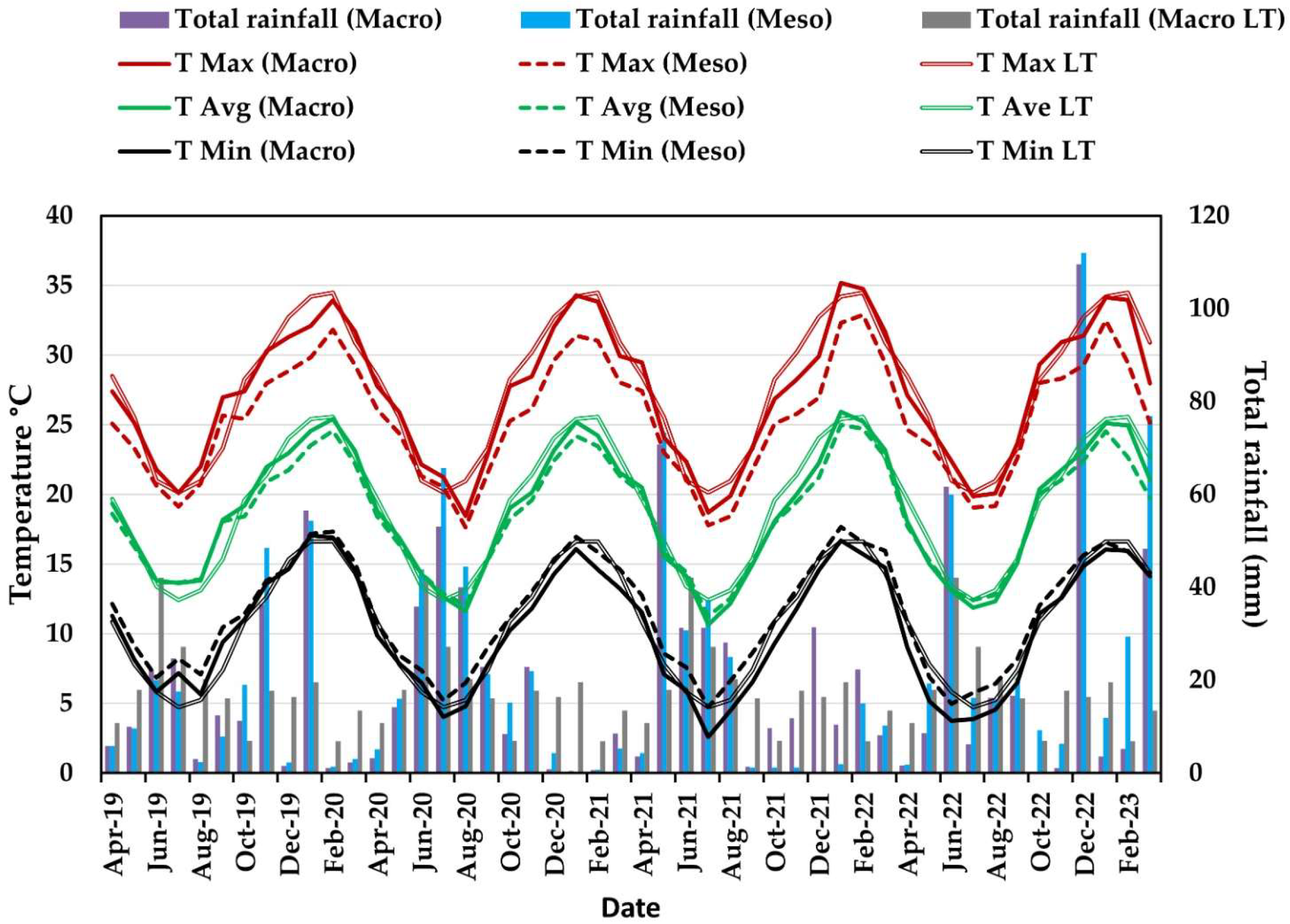
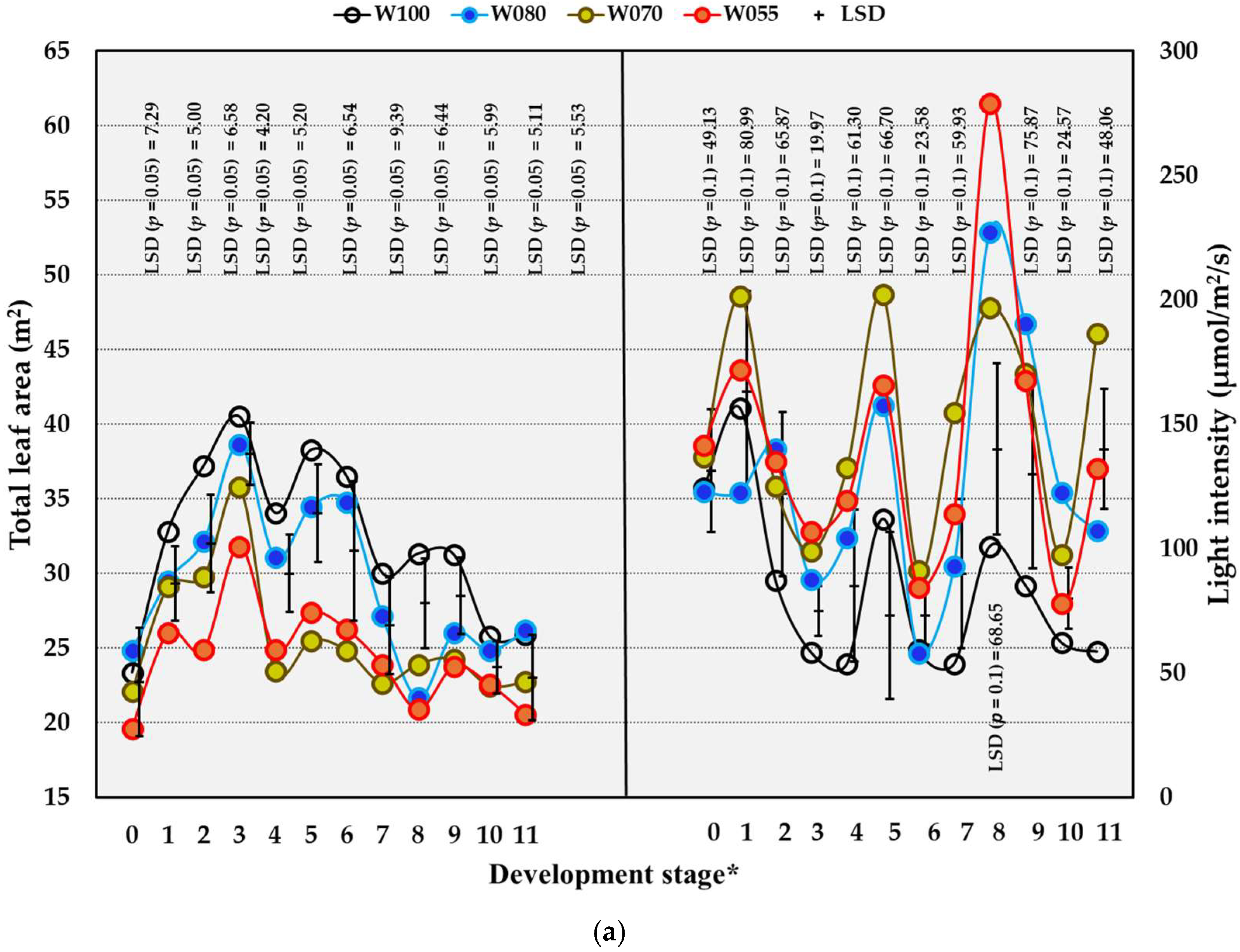
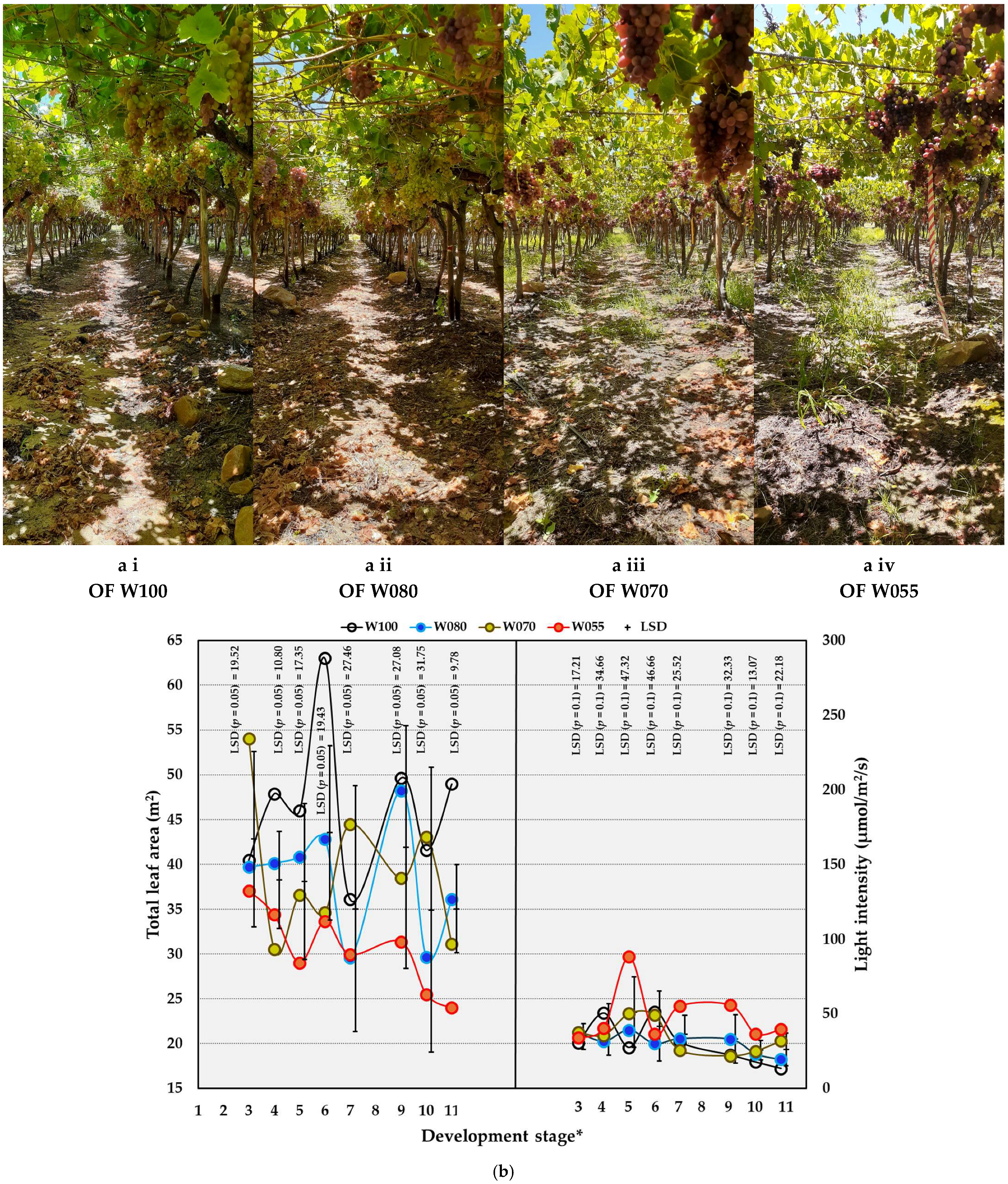
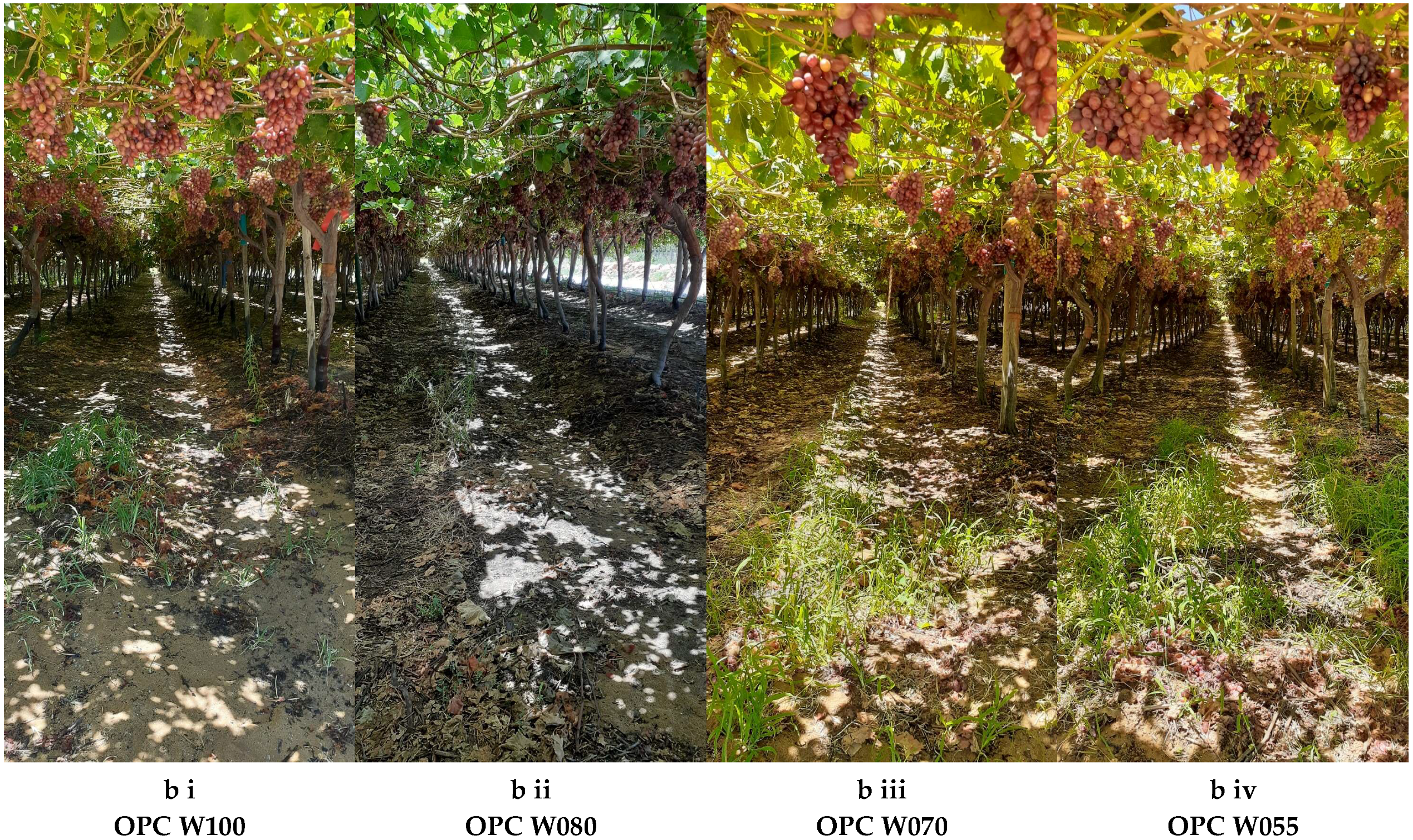

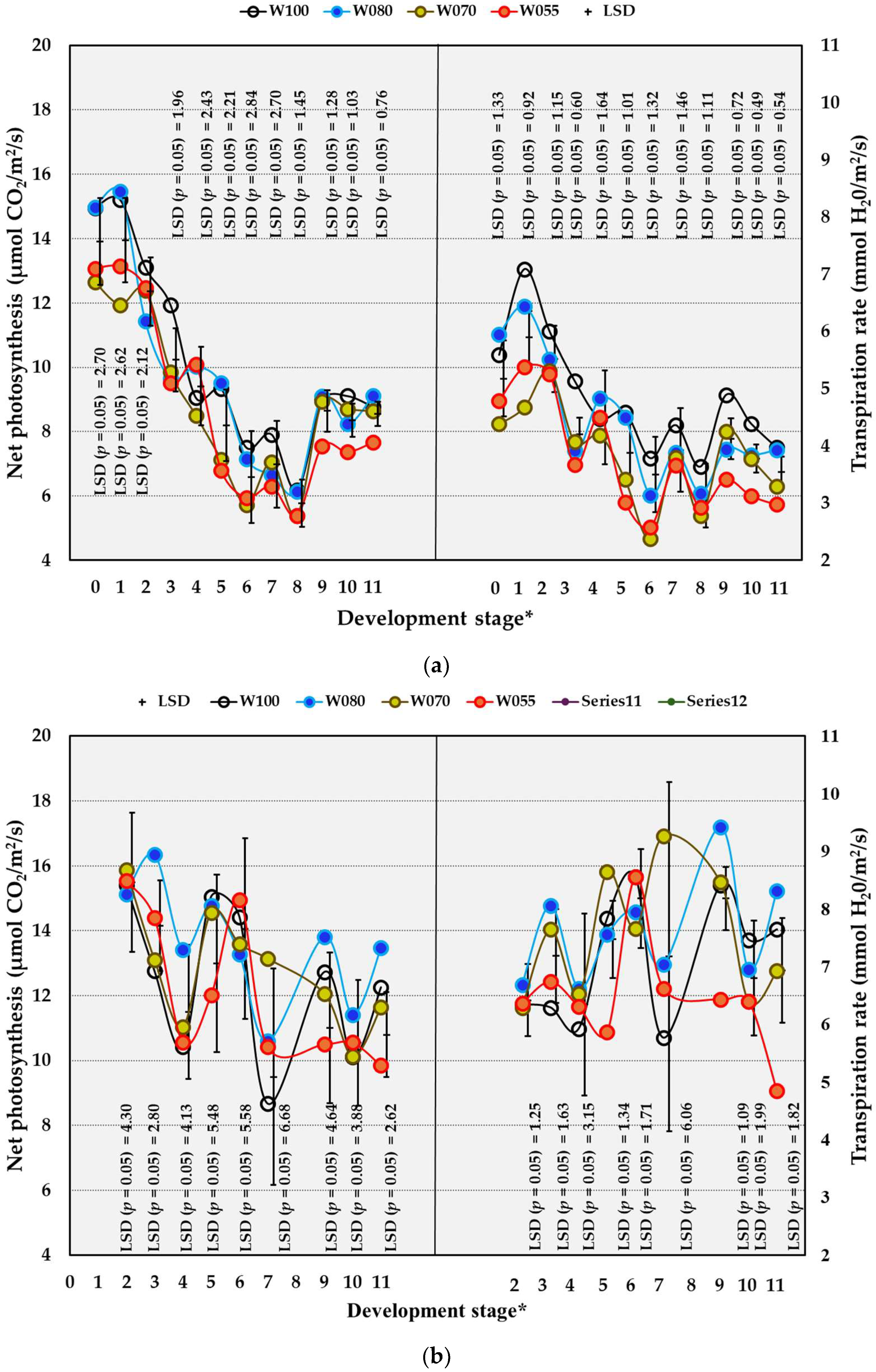
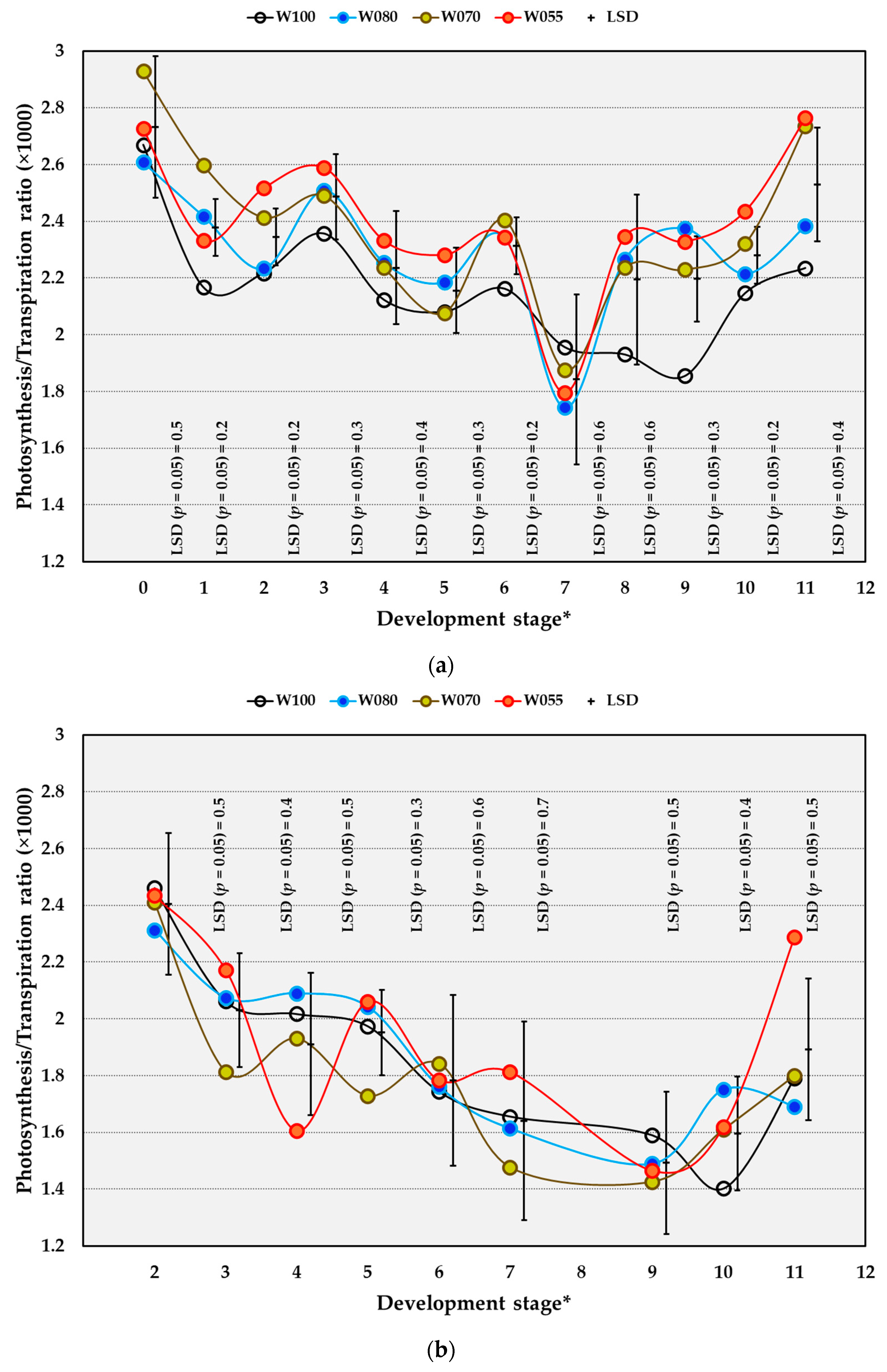
 = neutron probe measurement sites.
= neutron probe measurement sites.
 = neutron probe measurement sites.
= neutron probe measurement sites.
